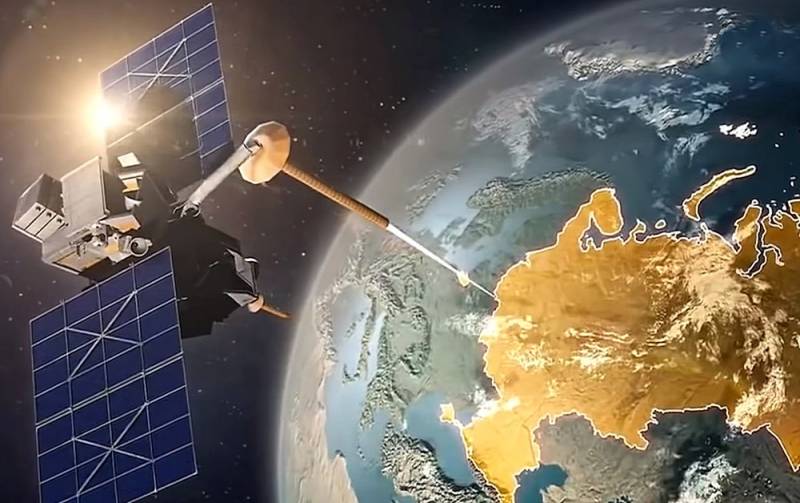"War of the Future" will begin with the destruction of satellites and orbital bombardment
In his recent interview, the head of the state corporation "Roscosmos" Dmitry Rogozin said that "the war of the future", if it happens, it will begin in outer space. Indeed, the aggressor will first have to disable the enemy's satellite grouping in order to "blind and stun" his troops. Then the missiles placed in orbit, launched in advance under some plausible pretext, such as "terraforming Mars", will deliver a preemptive strike in order to bleed the "nuclear triad" of the defender. And then the space elements of the aggressor's missile defense system will have to intercept the remnants of intercontinental ballistic missiles launched as part of a retaliatory strike. Something like this it might look like.
There is probably no need to name who is meant here by the aggressor and who by the defending side. This is already quite obvious, so let's talk about something else. In fact, the idea of the possibility of warfare in outer space has arisen for a very long time. As is often the case, it became a coincidence of a number of accidental circumstances. This is how it was.
On July 13, 1962, the first British satellite, called Ariel-1, unexpectedly went out of service. It was launched into orbit in order to study the effect of cosmic radiation on the processes occurring in the Earth's ionosphere on April 26, 1962 from Cape Canaverel in the United States. He left orbit exactly 14 years later, on April 26, 1976, day in and day out. However, it stopped working normally shortly after launch. For a long time, the British did not know what was the reason. Subsequently, it turned out that this was the work of their closest allies, the Americans, who did not even bother to inform them about it.
Here is how it was. Between April 25 and November 4, 1962, the United States conducted a series of near-Earth nuclear tests called Starfish Prime. The very first pancake turned out to be lumpy: on June 20, due to a malfunction in the rocket engine, it, along with a nuclear warhead, was lost and fell on the Pacific Johnston Atoll, which led to its radiation contamination. However, failure did not stop anyone. On July 9, 1962, during repeated tests over the unfortunate atoll at an altitude of 440 kilometers, a nuclear warhead with a W49 charge with a capacity of 1,44 megatons was detonated. Due to the lack of air at such a high altitude, there was no typical cloud in the form of a "nuclear mushroom". The inhabitants of Hawaii, located at a distance of 1500 kilometers from Johnston, could observe an unusually powerful glow for seven minutes. One of the notable consequences of a nuclear explosion in orbit was the shutdown of street lighting fixtures, the failure of radios and televisions in this Pacific state. But these were not the most interesting "special effects".
It turned out that an orbital nuclear explosion led to the failure of several satellites at once. The main victims are called TRAAC and Transit 4B devices, but the British Ariel-1 can be safely added to them. The nuclear explosion created a new temporary layer of radiation that immediately destroyed these satellites. Subsequently, due to the increased level of radiation, several more devices were out of order, and their solar batteries and electronic equipment had failed ahead of schedule.
Note that the Americans immediately established a relationship between their nuclear tests and the death of satellites, but did not consider it necessary to notify their British allies about this. The British had to come to the reasons on their own, comparing the facts and the results of their own research. On September 10, 1962, a report drawn up by the United Kingdom Department of Science was put on the table of Prime Minister Harold Macmillan. In it, Science Minister Lord Hailsham outlined the conclusions of his analysts, who concluded that Ariel-1 was inadvertently "burned" by the Americans. The rest is interesting.
At first, the British cabinet did not start an international scandal, presenting claims to the United States, but quietly put the report in a safe and classified it for the next 30 years.
Secondly, scientists and "geopoliticians" have come to exactly opposite conclusions. If the esteemed Lord Hailsham recognized the signing of a treaty banning nuclear tests in near-Earth space as necessary, the American and British military, on the contrary, saw remarkable opportunities in the unexpected effect of an orbital nuclear explosion. It has been since then that a real space arms race has been underway. All the great space powers are striving to develop the most effective ways to disable the enemy's orbital satellite constellations. This is the possibility of a targeted nuclear explosion in near-earth space, and the destruction of a special anti-satellite missile, and the insertion into orbit of the so-called "inspector satellites", which can presumably carry out an attack with a laser weapon or an electromagnetic pulse, and even the most real remotely controlled unmanned spaceplanes that are developing US military.
I would also like to express concern about the ideas of the famous American billionaire Elon Musk on the nuclear bombing of Mars, allegedly with the aim of terraforming it and creating an atmosphere on it. There is no practical benefit from this, but under this case the United States can put its nuclear missiles into orbit.

Information